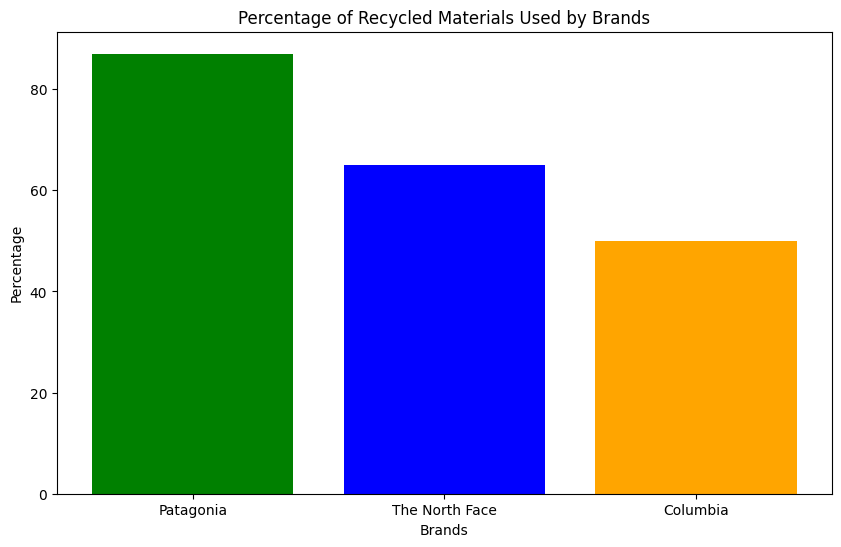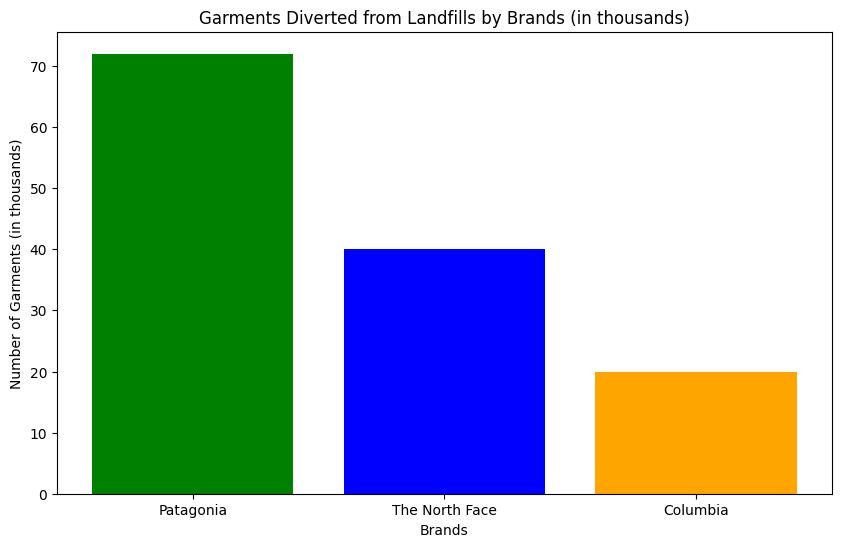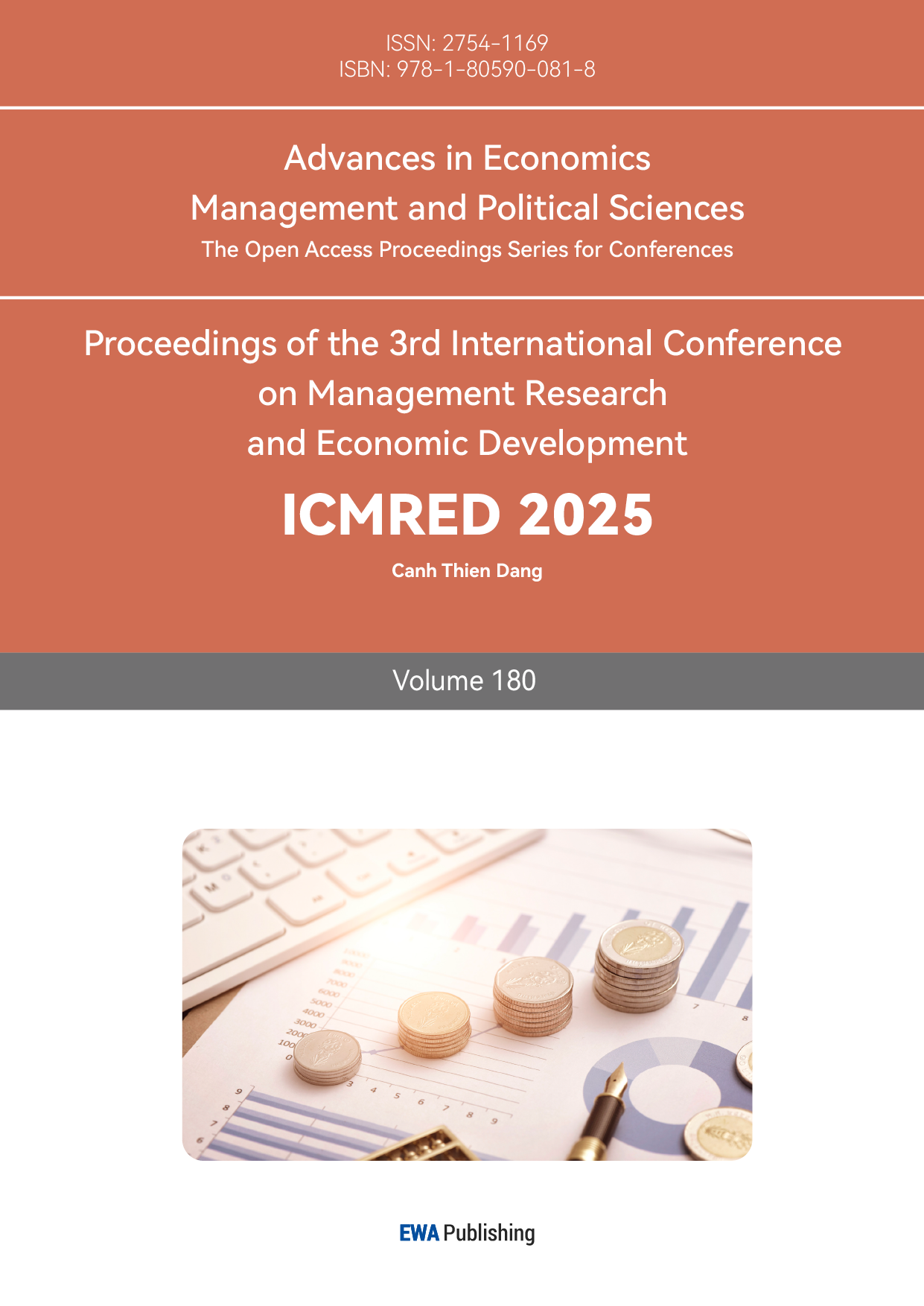1. Introduction
Customers today are becoming more aware of the impact of their purchasing patterns. Brands are facing increasing pressure to implement sustainable business practices in order to satisfy the growing need for environmental accountability as a result of civilization's rapid expansion [1]. Patagonia, is renowned for its strong environmental principles. It employs sustainable practices by giving ethical manufacturing practices and the usage of recyclable materials top priority. Patagonia promotes a number of things, including lowering carbon emissions and aiding environmental campaigning in addition to employing sustainable materials [2]. Patagonia has raised the standard for corporate sustainability with long-lasting products, ethical labor practices, and a steadfast dedication to environmental responsibility. Their commitment to openness, reuse and repair, and environmental advocacy shows that sustainability and profitability are compatible [3].
The research aims to investigate the following questions:
How effective is Patagonia's sustainability based branding in building consumer trust and loyalty?
Does sustainability branding translate into financial success, or is it merely a branding tactic?
How does Patagonia's brand perception compare to competitors in the sustainable fashion industry, such as The North Face and Columbia?
This study provides research insights to businesses which aims to create or optimize sustainability-driven marketing approaches. Because environmental product demand keeps rising, businesses need to evaluate if sustainability branding produces measurable results like keeping customers and building brand dedication and bettering their financial outcomes. The research findings will advance understanding both about CSR practices and ethical marketing strategies. This analysis of Patagonia promotes identification of sustainability branding’s vital success factors and presents actionable guidelines to companies wishing to execute sustainable programs. This research will establish a connection between marketing approaches and corporate responsibility to enable organizations to balance profits with sustainability achievements.
2. Effectiveness of Patagnoia’s sustainability strategy analysis
Patagonia stands as a sustainability model by unifying business operations with activist participation and open accountability standards. Reduction of environmental effects stands as the central element of this strategy since Patagonia set strict emissions reduction targets. Since 2017, Patagonia has reduced its direct operational emissions known as Scope 1-2 by 90% according to the company reports [4]. The company aims to achieve complete emission reduction across all scopes by 2040 while targeting reductions of 80% in Scope 1 and 2 emissions and 55% in Scope 3 emissions by 2030 [5]. Given that 95% of total emissions from Patagonia stem from supply chain activities known as Scope 3 emissions, collaboration with suppliers is crucial for achieving these goals [6].
Through material innovation Patagonia works as a main strategy to decrease environmental impacts. The company leads the industry when it comes to recycled material use since 87% of their products contain recycled content. Patagonia began using recycled polyester in outdoor gear in 1993 [7]. The company has set a sustainable goal to completely remove virgin petroleum materials from its production lines by 2025 thus achieving double benefits of waste reduction and resource independence. Additionally, Patagonia’s worn wear program and other circular economy initiatives at Patagonia enable users to repair and extend lifespan of their products instead of sending them to disposal [8]. Customer participation in the Worn Wear program led to the salvaging of 72,000 garments in 2023 which adds to the company's Ironclad Guarantee that cut replacement demand by 30% [9].
Sustainability investments by Patagonia have not hindered the company's financial success. The company reached $1 billion in estimated annual revenue during 2024 which marked quadrupled revenue growth from 2014 figures. The performance of Patagonia shows energetic growth with a B Corp score of 151.4 that exceeds the industry benchmark of 50.9 [10]. The 1% Earth Tax program of Patagonia enabled environmental donations totaling $100 million per year. The company's financial accomplishments demonstrate that sustainable practices can fuel business growth rather than forming an added expense to operations [11].
Beyond environmental initiatives, Patagonia utilizes its influence for both environmental protection efforts along with policy and social impact work. Apart from this, the business operates employee protection frameworks through Taiwan factories alongside establishing minimum wage requirements throughout 29 production facilities [12]. Since 2014, Patagonia’s Fair Trade Certified™ products have generated over $30 million in premium payments to workers, underscoring its commitment to fair labor practices. Through Patagonia Action Works, the company has linked more than 500,000 users with environmental groups since 2018. Additionally, its #VoteOurPlanet campaign helped register 120,000 new voters in the 2024 elections while showing its capacity to engage customers through environmental activities [13].
Despite its successes, Patagonia faces several challenges in executing its sustainability strategy. The primary challenge for stakeholders is dealing with Scope 3 emissions since it demands worldwide supplier cooperation. The supply chain source of textile dyeing contributes to 20% of freshwater contamination in manufacturing processes [14]. A 2024 MIT study also highlighted wage equity issues, revealing that 68% of apparel workers earn below the regional living wage. This challenge fair compensation in every segment throughout the supply chain. Additionally, Patagonia faces difficulties balancing its anti-consumerist positioning with its need for revenue growth through campaigns that urge customers not to purchase specific products [15].
Organizations have scientifically proven that Patagonia implements an effective Corporate Social Responsibility strategy. The sustainability efforts of Patagonia established higher customer loyalty rates by 40% and achieved employee retention better than average at 4% according to Luiss University in 2023 [16]. Futhermore, over 1,200 farms across the world have adopted the Regenerative Organic Certification, which the Rodale Institute and Patagonia developed. The success demonstrates environmental sustainability can match with commercial success but creates questions about implementation effectiveness for small enterprises. External audits indicate that 82% of Patagonia's sustainability goals stay on course, reaffirming the model’s effectiveness despite ongoing supply chain challenges [17].
3. Competitive analysis
The sustainability strategy implemented by Patagonia creates a strong impact against its counterparts including The North Face and Columbia. Unlike The North Face, Patagonia leads in sustainability by using 7% additional recycled materials and providing complete information about the recycling and dyeing of 28 material categories alongside ethical sourcing processes. The North Face provides its customers with only four material categories while keeping information about harmful substances concealed from public view. The North Face aims to eliminate plastic packaging by 2025 and reduce Scope 1-2 emissions by 50% by 2030; however, it provides limited transparency on progress tracking. As is shown in Figure 1 that the sustainability targets published by Patagonia each year show a track record of 82% [17].

Figure 1: Percentage of recycled material used by brands
The circular economy efforts of both brands include recycling programs and reuse programs. The Worn Wear initiative of Patagonia separated 72,000 pieces of clothing from landfills during 2023 although The North Face offers inconvenience for repurposing its products through second-hand channels. Since 2022, Patagonia has implemented 100% recycled packaging as The North Face sets its target at plastic-free packaging for 2025. Patagonia leads The North Face in customer trust and sustainability due to its superior B Corp status (151.4) that surpasses other competitors in the sector [18].

Figure 2: Garments derived from landfills by brands (in thousand)
It can be observed from Figure 2 that the product line of Patagonia consists of 87% recycled materials alongside completely organic cotton certification in all its products. While Columbia includes some recycled materials in its product creation the company does not publish plans for carbon reduction. Good On You reports that Colombia has received 2/5 on its environmental metrics yet Patagonia stands at 4/5 while Columbia does not demonstrate any initiatives to reduce waste in its supply chain. In terms of consumer engagement, Patagonia’s activism-driven campaigns like #VoteOurPlanet and the 1% Earth Tax contrast with Columbia’s focus on partnerships, such as the Planet Water Foundation [19].
Patagonia stands apart from competitors because it reports detailed emission and material information more extensively than competitors. The North Face and Columbia lack equivalent public disclosures. The Rodale Institute collaborates with Patagonia, supporting over 1,200 regenerative farms, while its competitors set internal targets without such external partnerships. Patagonia’s mission against consumption results in a 40% decrease of customer loss but The North Face focuses on delivering practical affordable products [20].
4. Conclusion
In conclusion, sustainability branding at Patagonia creates both improved brand trust and stronger customer loyalty. Transparent ethical processes and sustainable practices allow the company to stand out from other competitors in its market. The financial achievements of sustainability branding remain uncertain since market factors besides sustainability branding affect business success. Patagonia's strong financial performance demonstrates its successful integration of profitability and environmental responsibility through core sustainable business practices. The limitations of the study include reliance on secondary data, focus on a single brand, and obstacles in tracking the effects of sustainable development. Future research should expand to include more strategic elements, cross-industry analyses, and primary investigations through surveys and interviews for verification purposes. Overall, a deeper multi-dimensional analysis is required to comprehensively assess brand success and sustainability.
References
[1]. Aleksandar Grubor, & Olja Milovanov. (2016). Sustainable Branding. ENTRENOVA 2016. https://www.researchgate.net/publication/315860190_Sustainable_Branding
[2]. Golob, U., Burghausen, M., Kernstock, J., & Davies, M. A. P. (2022). Brand management and sustainability: exploring potential for the transformative power of brands. Journal of Brand Management, 29. https://doi.org/10.1057/s41262-022-00293-7
[3]. Shah, U. (2025). Sustainability as a marketing strategy: How brands are using eco-friendly design to win customers. The Financial Express. Retrieved March 9, 2025, from https://www.financialexpress.com/business/brandwagon-sustainability-as-a-marketing-strategy-how-brands-are-using-eco-friendly-design-to-win-customers-3756983/
[4]. Tomșa, M.-M., Romonți-Maniu, A.-I., & Scridon, M.-A. (2021). Is Sustainable Consumption Translated into Ethical Consumer Behavior? Sustainability, 13(6), 3466. https://doi.org/10.3390/su13063466
[5]. VanderLinden, S. (2024). What are Patagonia's Sustainability Practices: Key Initiatives and Impacts. Retrieved March 9, 2025, from https://www.researchgate.net/publication/315860190_Sustainable_Branding
[6]. Bocken, N. M. P., Allwood, J. M., Willey, A. R., & King, H. (2016). Development of a comprehensive framework for design for the circular economy—case study using PSS at Goodyear. Journal of Cleaner Production, 113, 4-16. Journal of Cleaner Production, 113, 4-16.
[7]. The Ellen MacArthur Foundation (2020). presents research in Completing the Picture: How the circular economy tackles climate change. Available at: www.ellenmacarthurfoundation.org
[8]. The Ellen MacArthur Foundation (2020). presents research in Completing the Picture: How the circular economy tackles climate change. Available at: www.ellenmacarthurfoundation.org
[9]. Forbes (2024). Patagonia’s Revenue Hits $1 Billion. Available at: www.forbes.com
[10]. Hethorn, J. & Ullmann, O. (2010). Sustainable Fashion: Why Now? A Conversation About Issues, Practices, and Possibilities. Fairchild Books.
[11]. Luiss University (2023). Study on CSR Impact of Patagonia. Available at: www.luiss.it
[12]. MIT (2024). Wage Equity in Apparel Industry. Available at: www.mit.edu
[13]. Patagonia (2023). Environmental & Social Responsibility Report. Available at: www.patagonia.com
[14]. Patagonia (2024). #VoteOurPlanet Campaign Results. Available at: www.patagonia.com
[15]. Porter, M. E. & Kramer, M. R. (2006). Strategy & Society: The Link Between Competitive Advantage and Corporate Social Responsibility. Harvard Business Review, 84(12), 78-92.
[16]. Rodale Institute (2023). Regenerative Organic Certification. Available at: www.rodaleinstitute.org (Accessed: 20 February 2024).
[17]. Science Based Targets Initiative (2022). provides information about science-based targets. Available at: www.sciencebasedtargets.org
[18]. WWF (2022). Textile Dyeing and Water Pollution. Available at: www.worldwildlife.org (Accessed: 18 February 2024).
[19]. Sheridan, N (2024), Patagonia Marketing Strategy 2024: A Case Study – Latterly.org, www.latterly.org.
[20]. Puente, C 2016, ‘PATAGONIA Individual Report’, www.academia.edu.
Cite this article
Wong,Y.A. (2025). A Study on the Effectiveness of Patagonia’s Sustainability-Driven Brand Strategy. Advances in Economics, Management and Political Sciences,180,302-306.
Data availability
The datasets used and/or analyzed during the current study will be available from the authors upon reasonable request.
Disclaimer/Publisher's Note
The statements, opinions and data contained in all publications are solely those of the individual author(s) and contributor(s) and not of EWA Publishing and/or the editor(s). EWA Publishing and/or the editor(s) disclaim responsibility for any injury to people or property resulting from any ideas, methods, instructions or products referred to in the content.
About volume
Volume title: Proceedings of the 3rd International Conference on Management Research and Economic Development
© 2024 by the author(s). Licensee EWA Publishing, Oxford, UK. This article is an open access article distributed under the terms and
conditions of the Creative Commons Attribution (CC BY) license. Authors who
publish this series agree to the following terms:
1. Authors retain copyright and grant the series right of first publication with the work simultaneously licensed under a Creative Commons
Attribution License that allows others to share the work with an acknowledgment of the work's authorship and initial publication in this
series.
2. Authors are able to enter into separate, additional contractual arrangements for the non-exclusive distribution of the series's published
version of the work (e.g., post it to an institutional repository or publish it in a book), with an acknowledgment of its initial
publication in this series.
3. Authors are permitted and encouraged to post their work online (e.g., in institutional repositories or on their website) prior to and
during the submission process, as it can lead to productive exchanges, as well as earlier and greater citation of published work (See
Open access policy for details).
References
[1]. Aleksandar Grubor, & Olja Milovanov. (2016). Sustainable Branding. ENTRENOVA 2016. https://www.researchgate.net/publication/315860190_Sustainable_Branding
[2]. Golob, U., Burghausen, M., Kernstock, J., & Davies, M. A. P. (2022). Brand management and sustainability: exploring potential for the transformative power of brands. Journal of Brand Management, 29. https://doi.org/10.1057/s41262-022-00293-7
[3]. Shah, U. (2025). Sustainability as a marketing strategy: How brands are using eco-friendly design to win customers. The Financial Express. Retrieved March 9, 2025, from https://www.financialexpress.com/business/brandwagon-sustainability-as-a-marketing-strategy-how-brands-are-using-eco-friendly-design-to-win-customers-3756983/
[4]. Tomșa, M.-M., Romonți-Maniu, A.-I., & Scridon, M.-A. (2021). Is Sustainable Consumption Translated into Ethical Consumer Behavior? Sustainability, 13(6), 3466. https://doi.org/10.3390/su13063466
[5]. VanderLinden, S. (2024). What are Patagonia's Sustainability Practices: Key Initiatives and Impacts. Retrieved March 9, 2025, from https://www.researchgate.net/publication/315860190_Sustainable_Branding
[6]. Bocken, N. M. P., Allwood, J. M., Willey, A. R., & King, H. (2016). Development of a comprehensive framework for design for the circular economy—case study using PSS at Goodyear. Journal of Cleaner Production, 113, 4-16. Journal of Cleaner Production, 113, 4-16.
[7]. The Ellen MacArthur Foundation (2020). presents research in Completing the Picture: How the circular economy tackles climate change. Available at: www.ellenmacarthurfoundation.org
[8]. The Ellen MacArthur Foundation (2020). presents research in Completing the Picture: How the circular economy tackles climate change. Available at: www.ellenmacarthurfoundation.org
[9]. Forbes (2024). Patagonia’s Revenue Hits $1 Billion. Available at: www.forbes.com
[10]. Hethorn, J. & Ullmann, O. (2010). Sustainable Fashion: Why Now? A Conversation About Issues, Practices, and Possibilities. Fairchild Books.
[11]. Luiss University (2023). Study on CSR Impact of Patagonia. Available at: www.luiss.it
[12]. MIT (2024). Wage Equity in Apparel Industry. Available at: www.mit.edu
[13]. Patagonia (2023). Environmental & Social Responsibility Report. Available at: www.patagonia.com
[14]. Patagonia (2024). #VoteOurPlanet Campaign Results. Available at: www.patagonia.com
[15]. Porter, M. E. & Kramer, M. R. (2006). Strategy & Society: The Link Between Competitive Advantage and Corporate Social Responsibility. Harvard Business Review, 84(12), 78-92.
[16]. Rodale Institute (2023). Regenerative Organic Certification. Available at: www.rodaleinstitute.org (Accessed: 20 February 2024).
[17]. Science Based Targets Initiative (2022). provides information about science-based targets. Available at: www.sciencebasedtargets.org
[18]. WWF (2022). Textile Dyeing and Water Pollution. Available at: www.worldwildlife.org (Accessed: 18 February 2024).
[19]. Sheridan, N (2024), Patagonia Marketing Strategy 2024: A Case Study – Latterly.org, www.latterly.org.
[20]. Puente, C 2016, ‘PATAGONIA Individual Report’, www.academia.edu.









